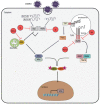Interferon-Mediated Response to Human Metapneumovirus Infection
- PMID: 30231515
- PMCID: PMC6163993
- DOI: 10.3390/v10090505
Interferon-Mediated Response to Human Metapneumovirus Infection
Abstract
Human metapneumovirus (HMPV) is one of the leading causes of respiratory diseases in infants and children worldwide. Although this pathogen infects mainly young children, elderly and immunocompromised people can be also seriously affected. To date, there is no commercial vaccine available against it. Upon HMPV infection, the host innate arm of defense produces interferons (IFNs), which are critical for limiting HMPV replication. In this review, we offer an updated landscape of the HMPV mediated-IFN response in different models as well as some of the defense tactics employed by the virus to circumvent IFN response.
Keywords: HMPV; IFN; human metapneumovirus; interferon; pneumovirus; respiratory.
Conflict of interest statement
The authors declare no conflict of interest.
Figures



References
Publication types
MeSH terms
Substances
Grants and funding
LinkOut - more resources
Full Text Sources
Other Literature Sources

